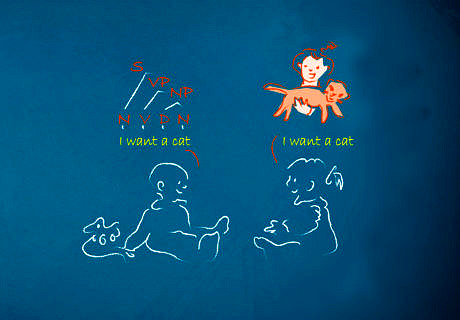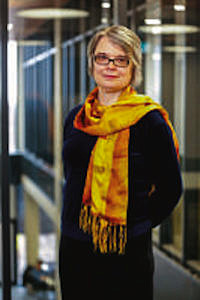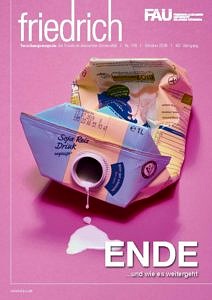Next, please!

An interview with Alexander von Humboldt Professorship holder Dr. Ewa Dąbrowska
Scientific theories are always being disproved and new ones put forward. Linguist Prof. Dr. Ewa Dąbrowska has made a contribution to disproving the theory of innate language ability widely accepted as an undisputed truth.
Interview: Ralf Grötker
Prof. Dąbrowska, in conjunction with your colleagues from the field of cognitive grammar, your work is currently bringing about a paradigm shift in the theory of language acquisition. What has been the leading theory in this area up to now?
Until recently, the theory of universal grammar was the accepted school of thought in language acquisition. It was developed by Noam Chomsky in the 1960s and has been accepted as popular knowledge ever since. The basic idea is an assumption that there is something in the brain that is responsible for enabling humans all over the world to acquire language in a similar manner in early childhood. This ‘something’ in the brain has a counterpart in the structure of language – all languages. At the same time, this special feature of the human brain explains why only humans, and not other mammals, have language in the real sense.
What speaks in favour of the theory of universal grammar?
Chomsky’s original argument was that language is extremely complex. At the same time, this complexity cannot be achieved just by listening to a language because spoken language simply does not contain enough information. This means it must be a skill we are born with.
What does the innate part of language consist of according to Chomsky?
Chomsky differentiated between the surface structure of a language, similar to what one can hear, and an underlying structure that one can acquire by investigating the structure of language. This all sounded very exciting and mysterious, of course. The idea that all languages are the same under the surface had quite a romantic touch. At the same time, the idea had a very democratic streak. Chomsky also assumed that all humans are born with the same linguistic abilities.
Isn’t it quite difficult to find a replacement for such a comprehensive large-scale theory as universal grammar?
First of all, you have to realise that Chomsky’s theory wasn’t actually all that comprehensive. Instead, it was changed several times over the years and the various versions differ significantly. What’s true, however, is that as a theorist, Chomsky likes to look at the bigger picture. He often let other people work on the details. The weaknesses of the theory start emerging as soon as you take a closer look at these details. We call what my colleagues and I can offer as a replacement usage-based construction grammar. The basic units of this grammar are constructions that unify aspects of content, form and function. ‘Thank you!’ is a very simple example of such a construction. Another example is the principle of ‘subject-predicate-object’ as a rule for constructing simple sentences. In contrast to Chomsky, we do not assume that all humans learn language in the same way, but that there are very different and individual routes to learning these constructions.
How do these constructions differ from Chomsky’s deep structures?
Construction grammar does not have any hidden structures. The whole thing operates mostly on the basis of WYSIWYG – what you see is what you get. To put it another way – languages abound in exceptions and irregularities. Full of irregularities. Chomsky, on the other hand, regards these irregularities as the periphery of language. He’s not interested in them as he believes a language mainly develops from what he calls the centre – from the abstract underlying structure that all languages have in common. Construction grammar assumes that quite the opposite is the case. Children learn to master the surface of language from the outset, including all the exceptions and irregularities. If they master this surface or periphery, it makes it easier for them to learn the abstract patterns.

Why has universal grammar been the dominant theory for so long, despite the shortcomings you’re referring to?
The main difficulty was probably that for a long time there simply was no alternative, but that is what we are now proposing with our usage-based approach.
What are the practical consequences of the paradigm shift you are hoping to bring about?
As far as I know, no-one has ever translated Chomsky’s universal grammar into a grammar textbook. This is precisely what we are able to do with construction-based grammar. A project called ‘Konstruktikon’ is getting underway at FAU headed by Prof. Thomas Herbst in which I will be taking part. It’s an online grammar portal for the English language based on usage-based construction grammar and managed by an international network. Another area of application I am personally looking into is using construction grammar to support people who have difficulty speaking and understanding language after suffering damage to certain areas of the brain after an accident or a stroke.
Would language teaching in schools be different if construction grammar gained wider acceptance as a background theory?
The opinion that children have more or less completely mastered all aspects of grammar already by the time they are four or five years old is still very widespread. This is also part of Chomsky’s teaching. However, in empirical studies, we have discovered that this is not the case. In terms of their linguistic capabilities, many five and six year olds are not at all ready for school and experience difficulties in school as a result. The blame for these problems is often put on poverty or parents who are not well educated. However, these factors are only partly to blame. If we acknowledge from the outset that the linguistic development of children of the same age can differ greatly and that children pursue very different cognitive strategies in order to learn a language, we can identify the children who need support in good time and develop the relevant programmes to help them.
Are there any aspects in the teaching programmes that should be changed?
Yes and no. Schools and teachers are repeatedly criticised for the fact that children and teenagers receive years of foreign language teaching and yet are far from fluent in the language at the end of the course. I think we need to put that into perspective. You need to consider that if children between the ages of one and five observe how people around them speak for eight hours every day and also communicate themselves, then this amounts to around 120,000 hours of being submerged in the language. When school pupils receive five hours of language teaching a week and another five hours of homework per week for four years, this doesn’t amount to even a fifth of the hours of the child surrounded by people speaking the language all the time. The fact that children continue to learn their native language far beyond the age of five also isn’t taken into account at all in this calculation either. The school pupils learning a language at school don’t perform so badly if you put things into perspective like this. However, there are aspects that could still be improved. Teachers often forget that it takes time and practice for pupils to be able to automatically use what they have learned. Lessons move on all to often to the next topic before pupils have had time to learn the previous topics properly.
One last question: Can you make a connection between any aspects from your own experiences in school or as a language learner with what you now know about construction grammar?
My family moved from Poland to the USA when I was a child. I could hardly speak any English and didn’t understand much of what the teachers were saying. After three months in my new school I had to take a grammar test. I was top of the class! The teacher didn’t really believe it at first and even checked for any signs that I had copied from the children sitting next to me. The fact that I only understood very little of the contents of the texts in the test actually helped me. I really had an eye for the formal structures of the language. I was able to confirm this effect several years later as a scientist in my experiments. Surprisingly, learners of a foreign language can sometimes recognise grammatical constructs better than native speakers.
friedrich – FAU´s research magazine

This article was originally published in our research magazine friedrich. The current issue deals with all aspects of the topic of ‘End’: which of them are unavoidable? How do people deal with this? What does it mean for individuals? Is what people define as the end really the end? Sometimes things just change or develop and something new is created. Occasionally, the end is not an issue at all, with the human race striving for eternity. Is it possible for us to understand this term at all? Is innovation infinite? And do we live forever – on the Internet?
Download friedrich 118 (in German language)
More articles from the magazine can be found under the keyword ‘friedrich’ (in German language).